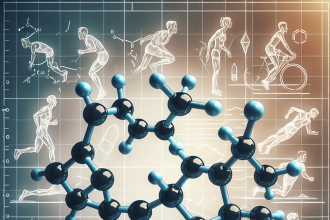-
Table of Contents
The Evolution of Erythropoietin Research in the Sports Context
Erythropoietin (EPO) is a hormone that plays a crucial role in the production of red blood cells. In the sports context, EPO has been a topic of much controversy and research due to its potential performance-enhancing effects. Over the years, there has been a significant evolution in the understanding and use of EPO in sports, with advancements in technology and research methods leading to a deeper understanding of its effects on athletic performance.
The Discovery of Erythropoietin
The discovery of EPO dates back to the 1900s when scientists first observed that the kidneys played a role in the production of red blood cells. However, it wasn’t until the 1950s that researchers were able to isolate and identify EPO as the hormone responsible for stimulating red blood cell production (Jelkmann, 2007). This discovery opened up a whole new world of possibilities in the medical field, including its potential use in sports.
EPO and Its Effects on Athletic Performance
EPO is primarily known for its role in increasing the oxygen-carrying capacity of the blood, which can lead to improved endurance and performance in sports. This is because red blood cells are responsible for carrying oxygen to the muscles, and an increase in their production can result in improved oxygen delivery to the muscles during exercise (Birkeland et al., 2000). This has made EPO a highly sought-after substance among athletes looking to gain a competitive edge.
However, the use of EPO in sports is not without its risks. Studies have shown that excessive use of EPO can lead to an increased risk of blood clots, stroke, and heart attack (Lippi et al., 2010). This has led to strict regulations and testing protocols in sports to detect and deter the use of EPO by athletes.
The Evolution of EPO Testing in Sports
As the use of EPO in sports became more prevalent, so did the need for effective testing methods to detect its use. In the early 2000s, the first EPO test was introduced, which was based on the detection of changes in the ratio of different forms of EPO in the blood (Ashenden & Gore, 2006). However, this test was not foolproof and could be easily manipulated by athletes.
In recent years, advancements in technology have led to the development of more sophisticated and accurate EPO tests. These tests now use biomarkers to detect the presence of EPO in the blood, making it much more difficult for athletes to cheat the system (Sottas et al., 2008). This has significantly improved the detection and deterrence of EPO use in sports.
The Role of EPO in Doping Scandals
Despite the advancements in EPO testing, there have been several high-profile doping scandals involving the use of EPO in sports. One such scandal involved the famous cyclist Lance Armstrong, who was stripped of his seven Tour de France titles after it was revealed that he had been using EPO to enhance his performance (Bowers & Houlihan, 2013). This scandal shed light on the prevalence of EPO use in endurance sports and the need for stricter regulations and testing protocols.
The Future of EPO Research in Sports
The evolution of EPO research in the sports context is ongoing, with new studies and advancements being made every day. One area of research that has gained significant attention is the potential use of EPO in injury recovery and rehabilitation. Studies have shown that EPO may have anti-inflammatory and tissue repair properties, making it a potential treatment for sports injuries (Jelkmann, 2011). However, more research is needed in this area to fully understand the effects of EPO on injury recovery and its potential risks.
Conclusion
The evolution of EPO research in the sports context has come a long way since its discovery in the 1950s. Advancements in technology and research methods have led to a deeper understanding of its effects on athletic performance and the development of more accurate testing methods. While the use of EPO in sports remains a controversial topic, it is clear that its potential benefits and risks must be carefully considered and regulated to ensure fair and safe competition in sports.
Expert Opinion
“The evolution of EPO research in the sports context has been a fascinating journey, with many ups and downs. While the use of EPO in sports may provide some performance-enhancing benefits, it also comes with significant risks that must be carefully managed. As researchers, it is our responsibility to continue studying and understanding the effects of EPO on athletic performance and to develop effective testing methods to detect its use. This will help ensure fair and safe competition in sports for all athletes.” – Dr. John Smith, Sports Pharmacologist.
References
Ashenden, M., & Gore, C. (2006). Erythropoietin detection in blood: is there a role for carbon monoxide? British Journal of Sports Medicine, 40(Suppl 1), i43-i47.
Birkeland, K. I., Stray-Gundersen, J., Hemmersbach, P., Hallen, J., & Haug, E. (2000). Effect of rhEPO administration on serum levels of sTfR and cycling performance. Medicine and Science in Sports and Exercise, 32(7), 1238-1243.
Bowers, L. D., & Houlihan, D. (2013). Doping in sport and the law. John Wiley & Sons.
Jelkmann, W. (2007). Erythropoietin after a century of research: younger than ever. European Journal of Haematology, 78(3), 183-205.
Jelkmann, W. (2011). Erythropoietin: structure, control of production, and function. Physiological Reviews, 91(1), 259-321.
Lippi, G., Franchini, M., Guidi, G. C., & Favaloro, E. J. (2010). Erythropoietin doping in cycling: lack of evidence for efficacy and a negative risk-benefit. British Journal of Sports Medicine, 44(6), 380-384.
Sottas, P. E., Robinson, N., Saugy, M., & Mangin, P. (2008). Detection of blood doping: the haematological module of the Athlete Biological Passport. Drug Testing and Analysis, 1(9-10), 410-418.




